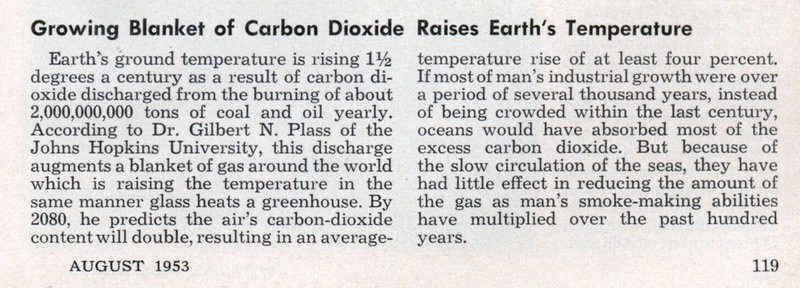On February 12, 1958, the American public saw the first televised warning about the dangers of carbon dioxide, global warming, and sea level rise. That warning came from The Bell Laboratory Science Series, which aired its fourth TV episode, “Unchained Goddess,” written and produced by three-time Oscar winner Frank Capra.
Capra is famous for classic films like “It’s a Wonderful Life,” and not so famous for having a degree in chemical engineering. In this film, Dr. Research (Dr. Frank Baxter) explains to The Writer (Richard Carlson) that unrestricted carbon dioxide emissions could lead to a world where “Tourists in glass bottom boats would be viewing the drowned towers of Miami”:
“Even now, man may be unwittingly changing the world’s climate through the waste products of his civilization,” warns Dr. Research. “Due to our release through factories and automobiles every year of more than six billion tons of carbon dioxide, which helps air absorb heat from the sun, our atmosphere seems to be getting warmer.”
Note: Now we are emitting six times (!) as much CO2 from fossil fuels as in 1958.
Is that “bad,” the Writer asks. Dr. Research explains:
“Well, it’s been calculated a few degrees rise in the Earth’s temperature would melt the polar ice caps. And if this happens, an inland sea would fill a good portion of the Mississippi valley. Tourists in glass bottom boats would be viewing the drowned towers of Miami through 150 feet of tropical water. For in weather, we’re not only dealing with forces of a far greater variety than even the atomic physicist encounters, but with life itself.”
Perhaps the show should have been titled, “Its a wonderful life — not!” Interestingly, despite what you might think from his most famous movie (and others, like “Mr. Smith Goes to Washington) — which appear to be stories of the little guy, the 99 percent vs. the 1 percent — Capra himself was a “conservative Republican” who “railed against” FDR. Also, Capra explained his comments to an early meeting of the show’s scientific advisory board, saying, “If I make a science film, I will have to say that science research is just another expression of the Holy Spirit that works in all men. Furthermore, I will say that science, in essence, is just another facet of man’s quest for God.” Back in the 1950s, at least, the science of global warming was not politicized or somehow seen as in opposition to religion.
While this appears to be the first televised warning, there was a warning broadcast on the radio show, “General Electric: Excursions in Science,” about the research of physicist Gilbert Plass.
Back in May 1953, Time magazine reported on Plass’s work in an article titled “Invisible Blanket,” which ends, “for centuries to come, if man’s industrial growth continues, the earth’s climate will continue to grow warmer.” So did Popular Mechanics:

As NASA wrote in a 2010 blog post on the Capra film, “Global warming is not a new concept”:
The Victorians knew about it. John Tyndall (born 1820) knew about it. So did Svante August Arrhenius. In April 1896, Arrhenius published a paper in the London, Edinburgh and Dublin Philosophical Magazine and Journal of Science entitled “On the influence of carbonic acid [CO2] in the air upon the temperature of the ground.”
In 1965, the president’s Science Advisory Committee warned President Johnson that “Man is unwittingly conducting a vast geophysical experiment,” and that “Within a few generations, he is burning the fossil fuels that accumulated in the earth over the past 500 million years.”
In 1979, the U.S. National Research Council assembled a panel of experts who wrote a report warning of the prospects for serious warming if we continued on the path of unrestricted carbon dioxide emissions. The panel explained, “A wait-and-see policy may mean waiting until it is too late.”
In 1981, James Hansen and six other NASA atmospheric physicists published a seminal article in Science, “Climate Impact of Increasing Atmospheric Carbon Dioxide.” That paper warned with remarkable prescience — or, I should say, with remarkable science — “Potential effects on climate in the 21st century include the creation of drought-prone regions in North America and central Asia as part of a shifting of climatic zones, erosion of the West Antarctic ice sheet with a consequent worldwide rise in sea level, and opening of the fabled Northwest Passage.” Check, check, and check.
The New York Times even reported on that study with the headline “Study finds warming trend that could raise sea levels.” By 1988, the science was so well understood and documented, the Intergovernmental Panel on Climate Change was set up by the U.N. and World Meteorological Organization to provide regular summaries and analysis of the science.
Scientists have been warning us about the dangers of unrestricted CO2 emissions, global warming and climate change for over six decades. So much for the myth that climate scientists used to believe in global cooling a couple of decades ago — a myth that has been utterly debunked in the scientific literature (see here). Heck, thanks to excellent reporting by InsideClimate News, we now know oil giant ExxonMobil had been told by its own scientists in the 1970s and 1980s that climate change was human-caused and would reach catastrophic levels without reductions in carbon emissions.
Perhaps it’s time all U.S. politicians — and the Supreme Court — start listening.
